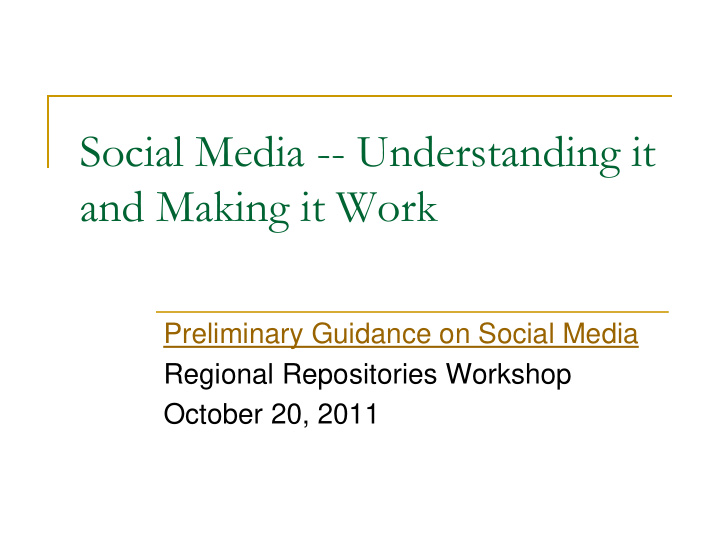



Social Media -- Understanding it and Making it Work Preliminary Guidance on Social Media Regional Repositories Workshop October 20, 2011
What is social media? “Social media is a subset of Web 2.0, which very broadly refers to any use of the Internet where the user helps determine content. A social media site allows its users to interact with the site’s creator, and with each other as contributors to the website’s content, and social media tools are intended to facilitate interactive information sharing, interoperability, user-centered design, and collaboration…” Examples: blogs, microblogs (Twitter), video sites (YouTube), photo libraries (Flickr), networking sites (MySpace and Facebook),and other interactive sites.”
Understanding the risks Increased vulnerability to cyber attacks and viruses Inappropriate use by content creators Noncompliance with legal requirements, especially retention and disposition
System security Ensure that use of social media is consistent with State policies State of Utah Social Media Guidelines Utah Administrative Code Federal guidelines emphasize the importance of technical controls, policy, and staff training Guidelines for the Secures Use of Social Media by Federal Departments and Agencies
Creating content Determine who is responsible for creating and uploading content: One staff member responsible, though ideas can come from others Control distributed through units of government Unmoderated use; no internal controls
Appropriate use by internal users Specify who is responsible for posting content All staff should be professional and comply with privacy and other laws Staff members must indicate whether they are speaking in an official capacity or offering a personal opinion Content contributors should identify themselves
Public comments Minimize risk by developing and posting a use policy which prohibits: example UDOT violent, obscene, profane, or hateful comments solicitations, advertisements, endorsements of non-governmental entities multiple off-topic posts by a single user Incorporate policies created by social media developers: example YouTube
Service providers Know the “terms of service” you are accepting Social media companies provide generic “terms of service” agreements rather than traditional contracts with customers. Some services offer customized memberships Some states recently successful in renegotiating “terms of service” agreements
Records Retention Determine whether content is a record Treat the site as one discrete record Determine whether content is covered by an existing retention schedule Manage communications sent via social media sites according to existing policies Only post content that will not create a risk if it is available indefinitely
Preserving Social Media Records Manage records with long-term retention in your own technical environment Use social media sites only as a delivery point Some tools allow users to extract data in XML. Preservation of some sites (Facebook) is particularly problematic
To be continued….. There is a growing body of literature relating to the use of social media in government. Stay tuned… Web.Content.gov Designing Social Media Policy for Government Navy Command Social Media Handbook How Federal Agencies Can Effectively Manage Records Created Using New Social Media Tools
Recommend
More recommend